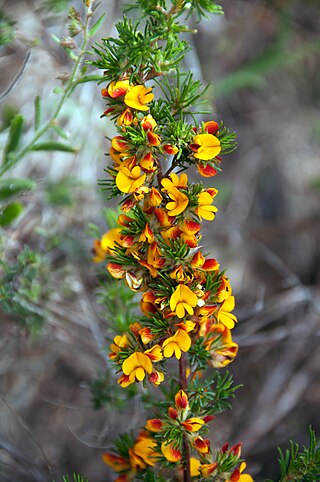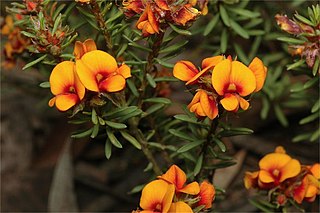
Pultenaea scabra, commonly known as rough bush-pea, is a species of flowering plant in the family Fabaceae and is endemic to south-eastern continental Australia. It is an erect or spreading shrub with hairy stems, heart-shaped leaves with the narrower end towards the base, and yellow and red, pea-like flowers.

Pultenaea muelleri, commonly known as Mueller's bush-pea, is a species of flowering plant in the family Fabaceae and is endemic to Victoria, Australia. It is a dense shrub with hairy stems, elliptic to narrow egg-shaped leaves with the narrower end towards the base, and yellow and red flowers arranged singly or in pairs on the ends of short side shoots.

Pultenaea densifolia, commonly known as dense-leaved bush-pea, is a species of flowering plant in the family Fabaceae and is endemic to southern continental Australia. It is a spreading or low-lying shrub with broadly egg-shaped, down-curved leaves and clusters of purple or yellow, red and purple flowers.

Pultenaea acerosa, commonly known as bristly bush-pea, is a species of flowering plant in the family Fabaceae and is endemic to south-eastern continental Australia. It is a rigid, much-branched shrub with glabrous, grooved, needle-shaped leaves and yellow flowers with red veins.

Pultenaea altissima, commonly known as tall bush-pea, is a species of flowering plant in the family Fabaceae and is endemic to south-eastern continental Australia. It is an erect shrub with spatula-shaped to egg-shaped leaves and yellow flowers in clusters at the ends of branches.
Pultenaea baeuerlenii, commonly known as Budawangs bush-pea, is a species of flowering plant in the family Fabaceae and is endemic to a restricted area of New South Wales. It is a small, erect shrub with linear, cylindrical, grooved leaves, and dense groups of yellow and red flowers, sometimes with red markings.
Pultenaea benthamii, commonly known as Bentham's bush-pea, is a species of flowering plant in the family Fabaceae and is endemic to south-eastern continental Australia. It is an erect shrub with sharply-pointed, narrow elliptic to linear leaves and yellow to orange and red flowers in clusters at the ends of branches.
Pultenaea canescens, commonly known as plumed bush-pea, is a species of flowering plant in the family Fabaceae and is endemic to a small area in eastern New South Wales. It is an erect shrub with narrow elliptic to narrow egg-shaped leaves, and yellow to orange flowers with reddish-brown markings.

Pultenaea elachista is a species of flowering plant in the family Fabaceae and is endemic to southern Australia. It is an erect, spindly shrub with hairy foliage, oblong to egg-shaped leaves with a pointed tip, and yellow flowers with red or orange markings.

Pultenaea glabra, commonly known as smooth bush-pea, is a species of flowering plant in the family Fabaceae and is endemic to eastern New South Wales. It is an erect shrub with glabrous stems, linear to egg-shaped leaves with a concave upper surface, and yellow to red and orange flowers.

Pultenaea hispidula, commonly known as rusty bush-pea, is a species of flowering plant in the family Fabaceae and is endemic to south-eastern continental Australia. It is an erect, spreading shrub with many drooping branches, oblong to egg-shaped leaves with the narrower end towards the base, and yellow to pale orange and red flowers.

Pultenaea largiflorens, commonly known as twiggy bush-pea, is a species of flowering plant in the family Fabaceae and is endemic to south-eastern continental Australia. It is a rigid, erect shrub with narrow egg-shaped leaves with the narrower end towards the base, and bright yellow and crimson flowers.

Pultenaea laxiflora, commonly known as loose-flower bush-pea, is a species of flowering plant in the family Fabaceae and is endemic to south-eastern continental Australia. It is a low-lying to prostrate, spreading shrub with linear to narrow egg-shaped leaves with the narrower end towards the base, and yellow and red to brown or purple flowers.

Pultenaea penna, commonly known as feather bush-pea, is a species of flowering plant in the family Fabaceae and is endemic to south-eastern continental Australia. It is a rigid, spreading shrub with linear, needle-shaped leaves and yellow and red, pea-like flowers.

Pultenaea pycnocephala, commonly known as dense-head bush-pea, is a species of flowering plant in the family Fabaceae and is endemic to eastern Australia. It is an erect shrub with hairy branches, egg-shaped leaves with the narrower end towards the base and yellow to red and purple, pea-like flowers.

Pultenaea reflexifolia, commonly known as wombat bush-pea, is a species of flowering plant in the family Fabaceae and is endemic to isolated parts of Victoria. It is an erect shrub with its foliage covered with tangled hairs, and has elliptic to narrow egg-shaped leaves with the narrower end towards the base, and yellow and red pea-like flowers arranged singly or in pairs on the ends of short side branches.

Pultenaea rigida is a species of flowering plant in the family Fabaceae and is endemic to south-eastern South Australia. It is a rigid, erect to prostrate, much-branched shrub with lance-shaped, sharply-pointed leaves and yellow and red to purplish flowers.
Pultenaea sericea, commonly known as chaffy bush-pea, is a species of flowering plant in the family Fabaceae and is endemic to south-eastern Australia. It is a small, straggling shrub with hairy branches, elliptic to linear leaves, and yellow and red to purple, pea-like flowers.

Pultenaea subalpina, commonly known as rosy bush-pea, is a species of flowering plant in the family Fabaceae and is endemic to a restricted area of Victoria. It is a rigid, prostrate to erect or spreading shrub with linear leaves and pink, pea-like flowers.

Pultenaea subspicata, commonly known as low bush-pea, is a species of flowering plant in the family Fabaceae and is endemic to south-eastern continental Australia. It is a low-lying, prostrate or mat-forming shrub with elliptic leaves and yellow to pink and orange-red, pea-like flowers.
















